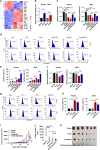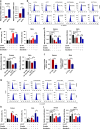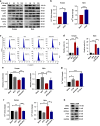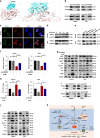Targeting PTGDS Promotes ferroptosis in peripheral T cell lymphoma through regulating HMOX1-mediated iron metabolism
- PMID: 39706989
- PMCID: PMC11833084
- DOI: 10.1038/s41416-024-02919-w
Targeting PTGDS Promotes ferroptosis in peripheral T cell lymphoma through regulating HMOX1-mediated iron metabolism
Abstract
Background: Peripheral T cell lymphoma (PTCL) is characterized by high heterogeneity, strong aggressiveness, and extremely poor prognosis. Ferroptosis, a novel form of programmed cell death, has been involved in tumor development and targeting ferroptosis holds great potential for tumor therapy.
Methods: Lentiviral transfection was performed to regulate gene expression, followed by Tandem mass tag (TMT)-mass spectrometry and RNA-sequencing. Tumor xenograft models were established for in vivo experiments.
Results: High expression of prostaglandin D2 synthase (PTGDS) was closely associated with poor prognosis of PTCL patients. PTGDS knockdown and AT56 treatment significantly inhibited the progression of PTCL through regulating cell viability, proliferation, apoptosis, cell cycle and invasion in vitro and in vivo. We further revealed that targeting PTGDS promoted ferroptosis process and enhanced the sensitivity of PTCL cells to ferroptosis inducers Sorafenib in vitro and in vivo. Mechanically, PTGDS interacted with heme-degrading enzymes HMOX1, and targeting PTGDS increased the level of iron and induced ferroptosis in PTCL through promoting HMOX1-mediated heme catabolism and ferritin autophagy process. Through the construction of H25A mutation, the specific gene site of HMOX1 corresponding to its role was identified.
Conclusions: Taken together, our findings firstly identified that targeting PTGDS promotes the ferroptosis in PTCL through regulating HMOX1-mediated iron metabolism, and highlighted novel therapeutic strategies to improve the efficacy of ferroptosis-targeted therapy in PTCL patients.
© 2024. The Author(s).
Conflict of interest statement
Competing interests: The authors declare no competing interests. Ethics approval and consent to participate: This study was approved by the Medical Ethical Committee of Shandong Provincial Hospital (SZRJJ:NO.2022-123) and written informed consent in accordance with the Declaration of Helsinki was obtained from each patient. All animal experiments were approved by Animal Care and Research Advisory Committee of Shandong Provincial Hospital (NO.SD NSFC 2023-0185). All methods were performed in accordance with its relevant guidelines and regulations.
Figures








Similar articles
-
Glycoprotein PTGDS promotes tumorigenesis of diffuse large B-cell lymphoma by MYH9-mediated regulation of Wnt-β-catenin-STAT3 signaling.Cell Death Differ. 2022 Mar;29(3):642-656. doi: 10.1038/s41418-021-00880-2. Epub 2021 Nov 6. Cell Death Differ. 2022. PMID: 34743203 Free PMC article.
-
LncRNA RGMB-AS1 inhibits HMOX1 ubiquitination and NAA10 activation to induce ferroptosis in non-small cell lung cancer.Cancer Lett. 2024 May 28;590:216826. doi: 10.1016/j.canlet.2024.216826. Epub 2024 Apr 2. Cancer Lett. 2024. PMID: 38574881
-
Juglone induces ferroptotic effect on hepatocellular carcinoma and pan-cancer via the FOSL1-HMOX1 axis.Phytomedicine. 2025 Apr;139:156417. doi: 10.1016/j.phymed.2025.156417. Epub 2025 Jan 25. Phytomedicine. 2025. PMID: 39923427
-
HMOX1 Promotes Ferroptosis Induced by Erastin in Lens Epithelial Cell through Modulates Fe2+ Production.Curr Eye Res. 2023 Jan;48(1):25-33. doi: 10.1080/02713683.2022.2138450. Epub 2022 Oct 27. Curr Eye Res. 2023. PMID: 36300537
-
Epigenetic alterations and advancement of treatment in peripheral T-cell lymphoma.Clin Epigenetics. 2020 Nov 7;12(1):169. doi: 10.1186/s13148-020-00962-x. Clin Epigenetics. 2020. PMID: 33160401 Free PMC article. Review.
Cited by
-
SH3GL1-activated FTH1 inhibits ferroptosis and confers doxorubicin resistance in diffuse large B-cell lymphoma.Clin Transl Med. 2025 Mar;15(3):e70246. doi: 10.1002/ctm2.70246. Clin Transl Med. 2025. PMID: 40038872 Free PMC article.
-
Decipherment of disulfidptosis-related mutation profile, chemosensitivity, and prognosis in diffuse large B-cell lymphoma.J Mol Med (Berl). 2025 Aug 18. doi: 10.1007/s00109-025-02571-8. Online ahead of print. J Mol Med (Berl). 2025. PMID: 40824493
-
OncoTrace-TOO: Interpretable Machine Learning Framework for Cancer Tissue-of-Origin Identification Using Transcriptomic Signatures.Cancer Rep (Hoboken). 2025 Aug;8(8):e70311. doi: 10.1002/cnr2.70311. Cancer Rep (Hoboken). 2025. PMID: 40784724 Free PMC article.
-
MT1G promotes iron autophagy and inhibits the function of gastric cancer cell lines by intervening in GPX4/SQSTM1.Sci Rep. 2024 Nov 18;14(1):28539. doi: 10.1038/s41598-024-80160-4. Sci Rep. 2024. PMID: 39558129 Free PMC article.
References
-
- Siegel RL, Miller KD, Wagle NS, Jemal A. Cancer statistics, 2023. CA: a cancer J Clin. 2023;73:17–48. - PubMed
MeSH terms
Substances
LinkOut - more resources
Full Text Sources
Medical
Miscellaneous

